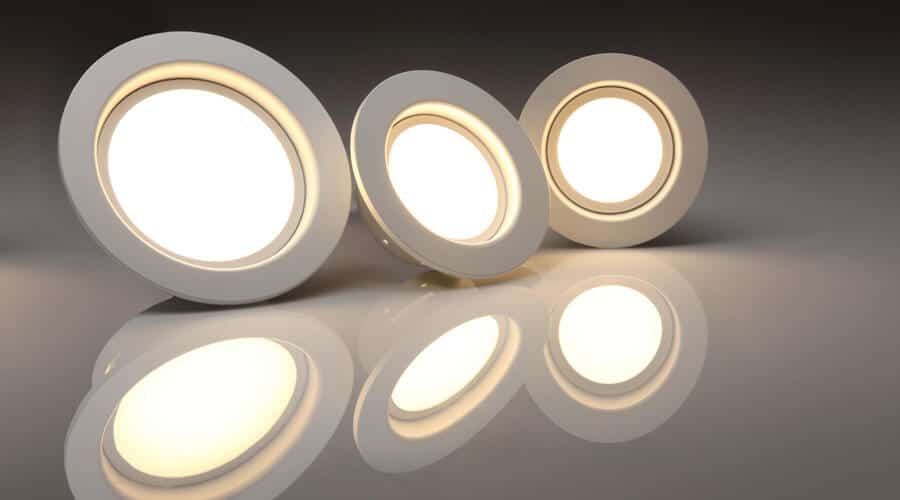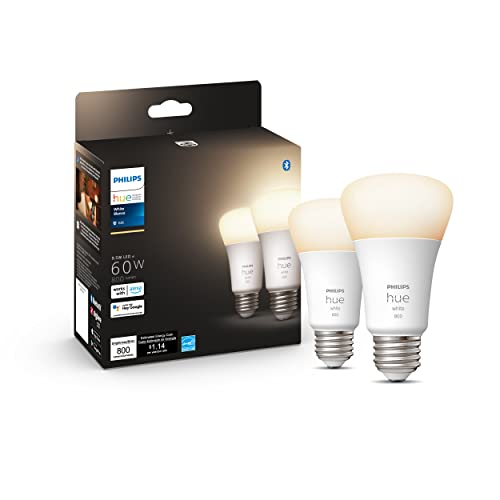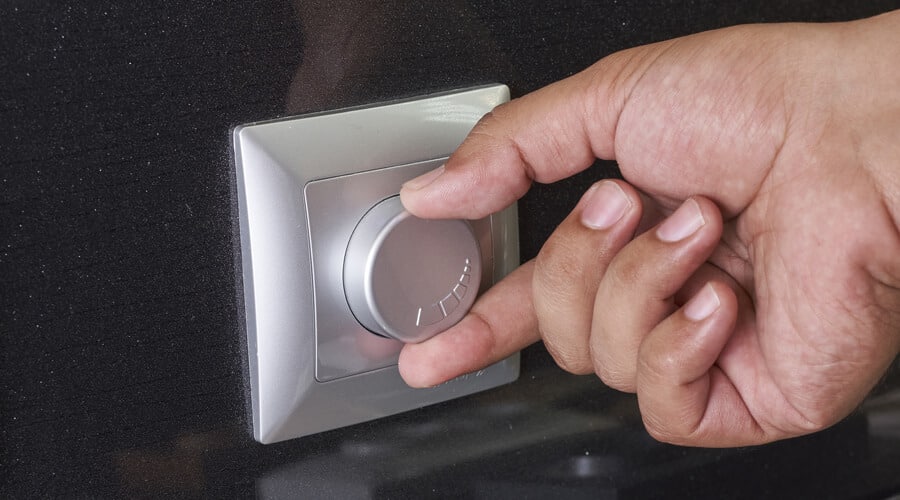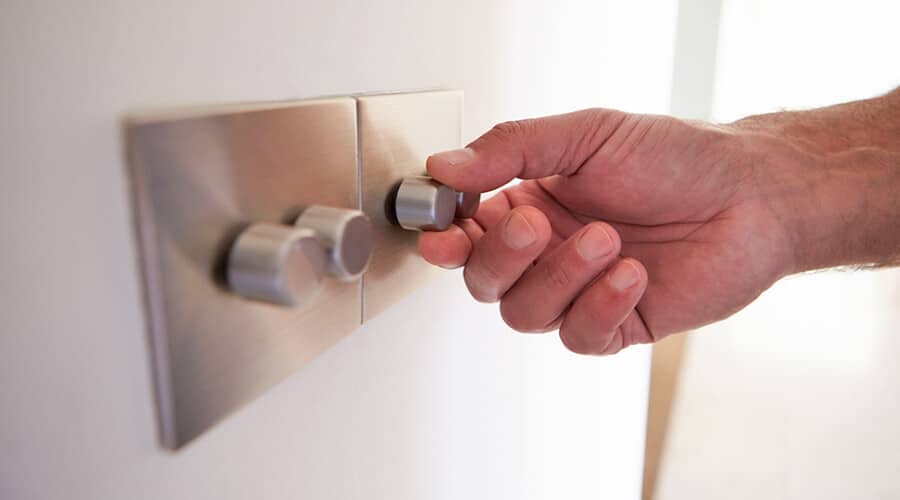Do light dimmers save energy? In times of high energy costs, it’s a very valid question. But as with many technical questions, the answer depends on the age and technology used in the dimmer and the type of bulb used.
The common assumption is that because dimmers reduce the amount of light produced by the bulb, that must mean less power is being used, and therefore light dimmers save energy.
This is true for modern dimmers but not necessarily for older dimmer units that introduce resistance into the circuit to dim the light output from the bulb.
What Is a Dimmer Switch?
A dimmer switch is a device added to a lighting fixture to dim or brighten lights to a specific level. They can be used to change the aesthetic or mood of a room.
For example, you might want a bright space to work in, but later on, use the same space to relax in later on.
How Do Dimmer Switches Work?
An older, standard dimmer switch reduces or increases the light bulb’s current flow, producing less light.
These dimmers – originally used as far back as the 1960s – are commonly used for dimming incandescent bulbs.
They do not use less energy as this design merely converts the energy to heat via adding or reducing circuit resistance using a rheostat device.
As a result, they are not as efficient as modern dimmers like the Kasa Smart Dimmer Switch or Lucron Aridni. These dimmers save energy when used with LEDs with a much lower rating and produce very little heat.
The technology used in newer dimmers – Triac Switches – turns the power to the bulb on and off quickly rather than adding resistance to the circuit.
Light is reduced or increased by varying the time the power is switched on. To the naked eye, this flickering is imperceptible.
does dimming lights save energy?
So does dimming lights save electricity? The simple answer is YES! In combination with LED bulbs, modern dimmers use less energy; as explained above, less electricity is used when the dimmer turns the power off to the bulb.
Also, LEDs are up to 80% more efficient than incandescent bulbs and don’t produce nearly as much heat.
With this combination, not only will you save money on your energy usage, but you’ll also be doing your part to help the environment by reducing your carbon footprint.

What Are The Benefits Of Using Dimmer Switches?
There are several benefits to using dimmers, including:
- Less energy consumption
- Longer life for light bulbs
- Greater control over lighting levels
- Enhanced ambiance and mood lighting.
Downsides To Using Dimmer Switches
While dimmers offer many benefits, there are also a few potential downsides to consider, such as:
- They can be more expensive than traditional light switches.
- They may not work with all types of bulbs.
- They can cause flickering if incompatible with the bulb or the electrical circuit is not up to code.
do dimmers save electricity?
Saving energy using a dimmer will depend on the wattage of the bulb and how much it is dimmed.
How much electricity do dimmers save? A standard 60-watt incandescent light bulb uses approx. 0.36 kWh per day if left on for 24 hours.
If 50% less light is output using a dimmer, you would be using approx. 0.18 kWh per day, resulting in a savings of approx. $0.09 per day or $32.85 per year*.
*Based on an electricity rate of $0.11 per kWh
While light dimmers on their own are not guaranteed to save you money on your energy bill, they are an easy way to reduce your energy consumption when combined with the right bulb.
The quick answer to do dimmers save electricity is yes, they do! If you are looking for more energy-efficient ways, dimmer switches save money in your home.
What Types Of Light Bulbs Work With Dimmers?
Most types of LED bulbs are compatible with a dimmer. However, there are a few things to keep in mind when using LEDs with dimmers:
- Make sure the dimmer is compatible with LEDs.
- The rating of the LED bulb should be equal to or greater than the wattage rating on the dimmer switch.
- If possible, use LEDs specifically designed to be used with dimmers.
It’s important to ensure the components are compatible with dimmers with LEDs to avoid potential issues. But if you follow these guidelines, you can take advantage of dimmer switches’ many benefits.
Dimmer switches save energy and generally give longer life to light bulbs. They enhanced the room’s ambiance and gave the homeowner greater control over lighting.
Dimmer switches can be more expensive than regular light switches, but the energy savings and other benefits make them a worthwhile investment.
With a few considerations to keep in mind, dimmers can be a great addition to your home.
Using Incandescent Light Bulbs With Dimmers
Although LED bulbs are the most popular type to use with dimmers, there may be some situations where you want to use an incandescent bulb instead.
In this case, you’ll need to make sure the dimmer switch is rated for incandescent bulbs and that the rating of the bulb is equal to or greater than the wattage rating on the dimmer.
When using an incandescent bulb with a dimmer, it’s important to ensure the components are compatible to avoid potential issues.
But if you follow these guidelines, you can take advantage of dimmer switches’ benefits.
Using Halogen Light Bulbs With A Dimmer
Halogen bulbs are another bulb that can be used with a dimmer switch.
As with incandescent bulbs, you’ll need to make sure the dimmer is rated for halogen bulbs and that the wattage of the bulb is equal to or greater than the wattage rating on the dimmer switch.
Using CFL Light Bulbs With A Dimmer
Unfortunately, you cannot use a dimmer with a standard CFL (Compact fluorescent) light bulb. If you try to use a CFL bulb in conjunction with a dimmer, it could flicker or may not light up at all.
They are effectively the same design as a fluorescent tube and are more energy-saving than standard incandescent bulbs.
However, you can buy special dimmable CFL bulbs that will not flicker or damage the dimmer. Check the packaging of CFL bulbs to see if they are dimmer compatible.
Using LED Light Bulbs With A Dimmer
As mentioned, LED light bulbs are the most popular type with dimmer switches. This is because they are energy-efficient, long-lasting, and don’t flicker with a compatible dimmer.
When using LED light bulbs with a dimmer switch, it’s important to ensure the dimmer used is of the modern variety that will work with LEDs, like the Lucron Diva.
The older type that simply varies resistance will not work.

How To Stop Dimmable LED Lights Flickering
If you are using dimmable LEDs and they are flickering, it’s likely due to one of these three issues:
- The wrong type of dimmer is being used.
- The electrical circuit is not up to code.
- The bulb’s wattage is incompatible with the dimmer’s rating.
If you’re having trouble with flickering LED lights, check the type of dimmer used and the wattage compatibility. Also, be sure the electrical circuit is up to code to avoid any potential issues.
Does Dimming Philips Hue Lights Save Energy?
Yes, dimming Philips Hue lights does save energy.
As they are based on LED technology – like other LED bulbs, they could save you up to 75% – When you dim the light, you effectively reduce the wattage used.
This will lower energy consumption and cost savings on your electric bill.
Philps Hue bulbs can last up to 15 years. Changing your household bulbs to Hue and multiplying the savings could add up to quite a lot over this period.
Some people may be put off by the high cost of these bulbs, but in the long run, they will pay for themselves many times over.
You should consider dimming your Hue lights with a Philips Hue dimmer to maximize energy saving. These switches – specially designed to work with Hue bulbs, can help to increase their lifespan.

By reducing the power being used, you are effectively extending the bulb’s life.
Philips Hue bulbs are also smart in that they are programmable.

You can save electricity costs by setting schedules and timers using the Hue phone App to switch them on or off after certain intervals.
If you have people in your household who move from room to room, switching on all the lights as they go, this can be a handy money-saving feature.
You can even connect your Hue lights up to a Philips Hue Play HDMI Sync Box to sync Hue-colored lights with music and movies to give your home entertainment system a visual boost!
So if you’re looking for a way to save energy and money, dimming your Philips Hue lights is a great option.
Not to mention numerous other features offered by Hue and the added benefit of extending the life of your bulbs.

What Are The Benefits Of Dimming Lights?
Switching to a modern dimmer will save some money, but by far, the biggest savings would come from a combination of a dimmer plus using a modern bulb rather than older power-hungry incandescent bulbs.
As per above, compatibility is one consideration when using a dimmer switch. Make sure the dimmer is compatible with the type of light bulb you’re using.
Another thing to consider is wattage. The wattage of the LED bulb should be equal to or less than the wattage rating on the dimmer switch to avoid overload problems.
Light dimmers can save energy but offer other benefits, including longer life for some light bulbs.
Older incandescent bulbs last longer with a dimmer as they are not subjected to an immediate step change to full voltage when switched on.
The gentler ramping up of voltage with a dimmer switch helps to reduce this initial shock to the bulb filament.
Other types, such as halogen bulbs, do not enjoy long life when used with a dimmer, as the gases inside the glass bulb operate best at high temperatures.
Dimmable LED lifespan is, however, mostly unaffected by dimming.
With a few considerations to remember and the added benefit of enhanced ambiance, dimmers can be a great addition to your home.
Frequently Asked Questions
How do light dimmers help save energy?
Light dimmers help to save energy by reducing the power delivered to the light bulbs. This not only saves energy but also increases the lifespan of your bulbs. When a dimmer is reduced to half-light, it may use close to half the energy of a fully bright bulb.
Can all light bulbs be used with dimmers to save energy?
Not all light bulbs are compatible with dimmers. Incandescent and halogen bulbs work well with dimmers. However, for compact fluorescent lamps (CFLs) and LED bulbs, you must ensure that the packaging indicates they are ‘dimmable.’ Using a non-dimmable bulb with a dimmer can lead to poor performance and potential safety hazards.
Does the dimmer itself consume a significant amount of energy?
While dimmers consume a small amount of energy, the amount is typically insignificant compared to the energy savings you can achieve by using them to dim your lights.
Can I use dimmers with my existing light fixtures, or do I need to install new ones?
You can usually install a dimmer switch on your existing light fixtures. However, consulting with a licensed electrician is recommended to ensure your existing fixtures are compatible with a dimmer switch.
Can I use light dimmers in combination with other energy-saving practices?
Absolutely. Light dimmers can complement other energy-saving methods, such as using energy-efficient bulbs, turning off unused lights, and using natural light during the day.
Are there different types of dimmers, and do they all save energy in the same way?
Several types of dimmers exist, including rotary, slide, toggle, and touch dimmers. While all dimmers can save energy by reducing the amount of electricity sent to the bulb, their efficiency can vary based on the type and quality of the dimmer and the type of light bulb being used.
Will using a dimmer change the color of my light?
Using a dimmer can change the perceived color or warmth of the light emitted from a bulb, especially with incandescent and halogen bulbs. As the dimmer reduces the light’s intensity, the bulb’s color temperature can become warmer (more yellow). This can create a comfortable and relaxing atmosphere in many living spaces.
Does installing a light dimmer require professional help?
Installation of a light dimmer involves handling electrical wiring. While someone with experience in DIY home improvement projects can install a dimmer, we always recommend getting assistance from a professional to ensure a safe installation.
Do LED lights get dimmer with age
LED lights do not get dimmer with age in the same way as incandescent bulbs do. However, they do have what’s known as “lumen depreciation”, meaning that the amount of light they produce can decrease over time.


